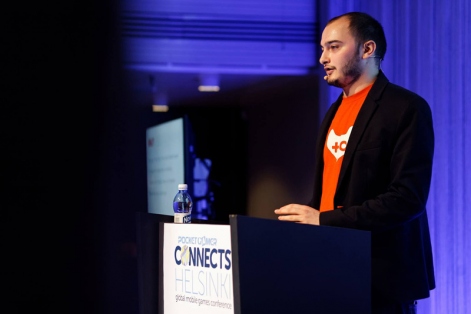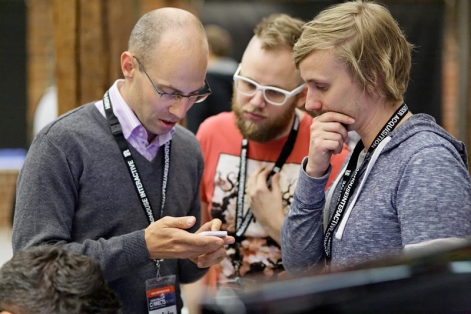5 unusual observations concerning the mobile gaming industry
We publish a funny and at the same time very interesting article about the current indie developers authored by Gur Dotan, co-founder and vice president of marketing at SOOMLA.
Returning back to the hotel from a party at the Pony Bar, which was dedicated to the conference, I was thinking about the children with a laptop gathered at the next table. After showing their freshly baked project to the mass of visitors of the exhibition all day, they had the perseverance and strength to bring their project to the bar, where they started playing again, and not drinking as they should.
Such dedication to the game perfectly reflects the nature of the two conferences I attended a couple of weeks ago: PGConnects Helsinki and DevGAMM. They cannot be called very large, rather, on the contrary, local, personal. The nature of these events and the people I met at them made me think about the state of independent development. Just below are the observations I have collected.
Observation one: indies are completely ignorant of working with data and analytics
Apparently, independent developers still ignore the need to implement analytical solutions to understand the players. In an industry that offers so many free project management solutions, based on the data obtained, it is shocking that developers do not fully understand the importance of analytics.
I’ve talked to people who were passionate about development to the point of completely neglecting marketing aspects after launch. This was true both for those who develop mobile games and for developers of PC projects (especially for them).
The question I asked many independent studios (both consisting of one person and numbering about 30 people on staff) was formulated as follows: what tools do they use for analytics and how do they measure retention. Here are some of the answers I received:
Studio 1
- Me: What’s with your retention? How do you measure it?
- Studio: No idea. I launched the game without analytics. I’ll add it later.
- I (to myself): What the fuck…?
Studio 2
- Me: So which analytical platform do you use?
- Atelier: We have created our own analytical system.
- Me: Wouldn’t it be better to use a recognized solution with an appropriate level of analytical expertise that you don’t own?
- Studio: At the moment, our solution is enough for us, and we prefer to code everything on our own.
Studio 3
- Studio: Yes, of course, we are conducting A/B testing. We are conducting tests to determine the best game screen for interstitials (interstitials).
- Me: And how do you do it?
- Studio: Well… we are releasing an update with ads at the end of the level. We look at how it works for two weeks, and then we release a new update in which the ads are located elsewhere.
- Me (stunned): Seriously? Haven’t you heard anything about remote A/B testing platforms?
Observation two: The publishing paradox of Indie
The publishing paradox is a classic catch-22 [a contradictory situation devoid of a logical solution, since its fulfillment is excluded by the conditions set. For example, “You can get a job only if you have work experience. In order to have work experience, you need to work,” – ed.]. The situation is that when you are a small, instant noodles-eating developer whose product has not yet come out and has not started to generate income, no one will publish you, despite the fact that at this moment you need a publisher most of all. As soon as you launch a project and become popular, you have the opportunity to think through, calculate how you can build a profitable business.
Ironically, this is exactly the time when publishers are actively going to hit on you. Publishers will offer deals when you least need them and will ignore you when you need them. The catch-22 here is that you need money to reach the point where you will be ready for publication, but first you need to be ready for publication in order to get this money.
Winners of the Very Big Indie Pitch at PGConnect Helsinki 2015
Smart indie studios can balance at the point between an immediate release with mediocre indicators and a rapid growth of downloads in the charts with a scalable business model. At the moment when your game has reduced ROI risks by becoming popular and proving the viability of the monetization model, you have to make an important decision.
If you have a business acumen and believe in your strength to raise the game to the top, forget about publishers. On the other hand, if you have a diamond in your hands and you have no idea how to turn it into a diamond, it’s time to start looking for a publisher who knows how to scale your success. There were both on PGConnects and DevGAMM. Few of them have found publishers.
Observation three: new, innovative monetization platforms are gaining momentum
Ask any mobile game developer how they monetize their game. I assure you, you will hear the same answer from all of them: IAP and advertising. There are well-known industry standard techniques for generating in-game revenue. The same is shown in the App Annie report here.
Other methods of monetization of users, which have become possible thanks to the emergence of powerful platforms with innovative ways to stimulate the success of games from independent developers, are still almost not discussed. Despite the fact that everyone today is obsessed with video advertising and in-game coins, many lesser-known startups are trying to promote new forms of retention and monetization in mobile gaming. The following attracted me to PGConnects:
Pollen VC
Pollen is something like a smart investment bank for mobile games. This service allows you to directly reinvest the proceeds of your game in the purchase of users, instead of receiving a receipt. In the current difficult time of high ratings, this will provide you with the necessary fuel.
GiftGaming
This service offers real gifts and coupons in exchange for in-game currency. Unlike installing another application and watching videos to receive in-game moents, you can choose to receive a real gift from the advertised brand. The user will earn twice on this: on receiving a gift and on receiving in-game currency.
Gumbler
An esports platform for holding daily contests and distributing prizes. This service will increase both retention and monetization of the project. You can arrange daily competitions that will last a week. Every day, players receive a free attempt to participate in the contest. If someone crashes and wants to achieve a record (and a prize), they must pay to participate in the competition.
And now a five-minute shameless self-promotion. My company, SOOMLA, has also joined the trend. We bring innovation to user retention by building a collective in-game data network. Our platform can show developers the history of the IAPs made by new users in real time. Developers can use this data to take specific actions regarding each user: offer bundles to “whales”, target spenders with special push companies and increase the number of ad impressions to those who do not spend money in the game.
Observation four: Child directors at conferences
It is quite common to see a 22–year-old at a conference with the badge “CEO” (or “Technical Director”, or some other “director”). With all these halls where you can watch and show a mobile game, and studios – to meet the very only investor, PGConnects and DevGAMM – cultivate a “young, unfamiliar tribe”.
Twenty-something-year-olds who are still crushing pimples and at best studying at university, and at worst in high school, create some of the best works in the world in the field of three-dimensional graphics, sound effects and game mechanics.
A new generation of directors
And all this is done by some within the framework of small teams. The programmer-artist-designer link secretly “in the garage” create games, naming themselves coveted positions, a la “director so-and-so”.
It can be hard not to grin when faced with any of them, but at the same time I appreciate them very much – including for believing in themselves, since they take such high-profile titles, proclaiming themselves as a real company. During these conferences, I personally witnessed how the ability to keep a face, to seem mature… or the lack of this skill determined the success of the meeting with a potential publisher.
Observation five: the northern hemisphere has lost its head because of the games
Finland, Sweden, Denmark, Russia, Germany, Japan, South Korea and Canada… and not only… If you take a globe and mark the countries most engaged in the industry on it, you will notice that many of them are located in the northern hemisphere.
It’s cold out here
I am not an expert on the labor market or anthropology, but the first thing that comes to mind in this regard is that such popularity of games here is explained by the cold climate. People spend less time on the street, therefore, they need more home entertainment, and what could be more exciting than games?
Bonus observation: Players like old-fashioned beards
As in the case of the previous observation, I cannot provide empirical evidence, but I also cannot ignore the fact that numerous players, developers, artists and designers wear huge beards. A healthy Viking-style beard is especially popular.
Thick, thick beards
There is a feeling – this is exactly true for some independent teams – that various subcultures (with their heavy music, tattoos, dungeons, costumes and generally such a medieval atmosphere) are pouring into the gaming crowd. This is reflected both in the games they create and in the clothes and beards they wear.
For me, it’s very cool!
The publication was made with the permission of the author of the original material.
Source: PocketGamer.biz
You will be able to learn about the latest trends in the gaming industry first-hand, personally meet and discuss working issues with leading companies in the game development and publishing market at White Nights Moscow 2015, which will be held on October 13-14.




